#south american canids
Explore tagged Tumblr posts
Text

Darwin's fox (Lycalopex fulvipes) Chiloé Island, Chile
Photo © Kevin Schafer / Minden / naturepl.com
#south american canids#south american foxes#darwin's fox#chilean wildlife#south american wildlife#op
128 notes
·
View notes
Text
Take all the really big mega-wolves in fantasy that insist on calling themselves dire wolves even though they’re nothing like a dire wolf. Now replace them all with scientifically accurate aenocyon dirus specimens. Watch the plot fall apart as the main characters ride away through the snow on a weird looking dhole-like animal that’s just barely bigger than a regular wolf.
#dire wolf#dire wolves#aenocyon#paleontology#Wolves#canidae#extinct animals#pleistocene#aenocyon dirus#South American canids#Evolution#fossil#extinction#natural history#biology
4 notes
·
View notes
Text


#animal polls#poll blog#my polls#maned wolf#canidae#canid#south american wildlife#south america#wildlife#near threatened
118 notes
·
View notes
Text
official canidae post!
Shoutout to the maned wolf, which is technically neither wolf nor fox but has its own genus called Chrysocyon! Why -

why are your legs so long?
I mean, intellectually, I understand that it’s because you live in grasslands and have evolved to be able to see over the grass, but emotionally… why? Are they?? Like that??? Surely there was a way to make your body more cohesive and proportional-looking?
118K notes
·
View notes
Text







Maned wolf (Chrysocyon brachyurus), family Canidae (canids/'dogs')
Despite often being compared to wolves or foxes, it is only distantly related to either group. Its closest living relative is the bush dog, though it also has more distant relationships with other South American canids.
Dierenpark Zie-ZOO, taken August 2024
#animals#zoo#zoo photography#nature#maned wolf#Chrysocyon brachyurus#canidae#canids#canid#dierenpark zie-zoo#yes this one had a damaged ear but unfortunately the other one was way shyer so have no good pictures of it#so excited to saw these guys getting fed because they're usually almost impossible to spot
38 notes
·
View notes
Text
Everyone's talking about the 4B movement coming to the US like it's some new radical thing, as if political lesbianism didn't happen and was hardly effective. No matter what the average woman is in fact straight regardless of jokes and fantasies about how women can be seduced by other women. There's just always going to be loser women desperate for any type of companionship. I don't think this 4B stuff is going to go anywhere and from what I've seen it hasn't even gone anywhere in it's place of origin, South Korea. It looks to be an idealistic, terminally online movement. Perhaps I am misinformed and cynical but if American women couldn't even rile together to vote for a specific canidate, they're definitely not going to rile together for a sex strike. Especially as the US economy is likely to get worse.
12 notes
·
View notes
Text
Animal of the Day for November 8: Terror Bird (Family Phorusrhacidae)

While mammals took over after dinosaurs died out, this was not completely the case. In South America, the Terror Birds were among the dominant predators, along with giant crocodilians, notosuchians and snakes, some of which are still alive today.
A common myth is that the Terror Birds went extinct due to competition with placental mammals during the Great American interchange (an event when the Americas became connected by a land bridge, causing ecological chaos), but Terror Birds managed to coexist just fine with the likes of canids and big cats. Instead, the Terror Birds may have failed to endure the ice age.
#animal of the day#november 8#november#terror bird#extinct animals#birds#raptors#south america#north america
12 notes
·
View notes
Text
So Minecraft has new wolves!!
I am very happy about this, but it does make me curious what species each variation is based off of! You too? Awesome!

Rusty Wolf = Dhole
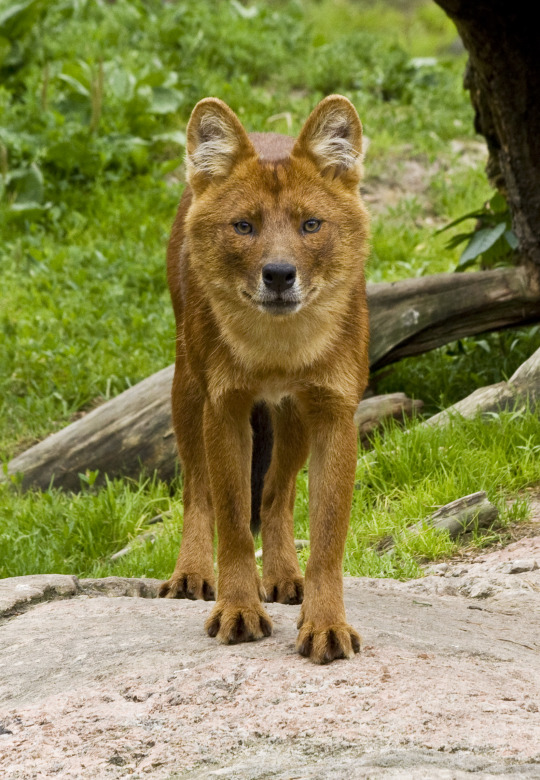
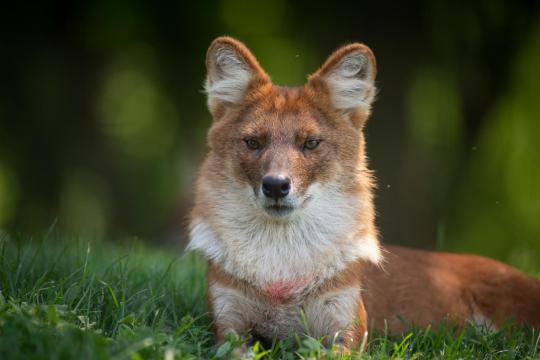
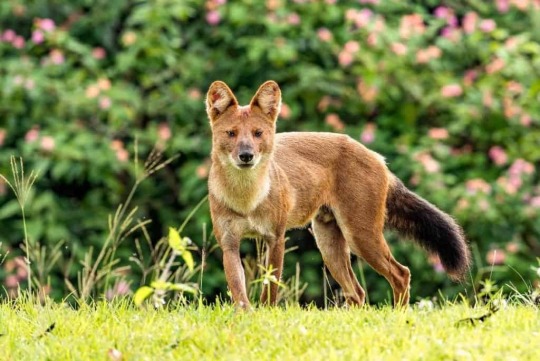
Seeing a little red jungle wolf took me right back to reading The Jungle Book as a kid, so I pretty much instantly decided they were dholes! A.k.a. Asian wild dogs or red dogs. They're an endangered canid native to Central, South, East and Southeast Asia, and they live in large clans ranging from 12-40 members.
Pale (Original) Wolf & Black Wolf = Grey Wolves
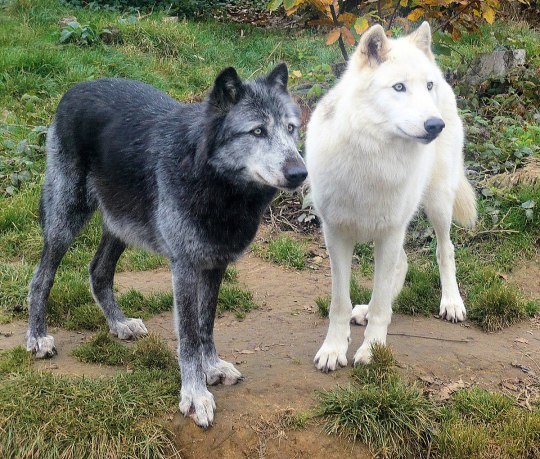
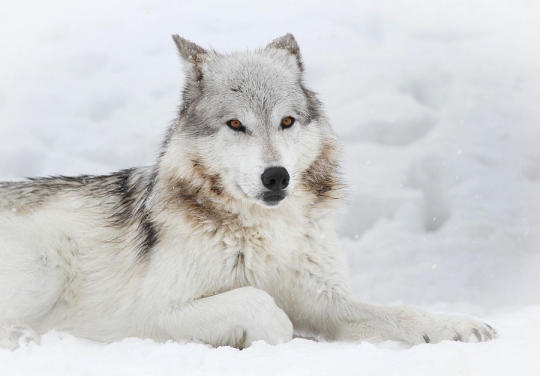
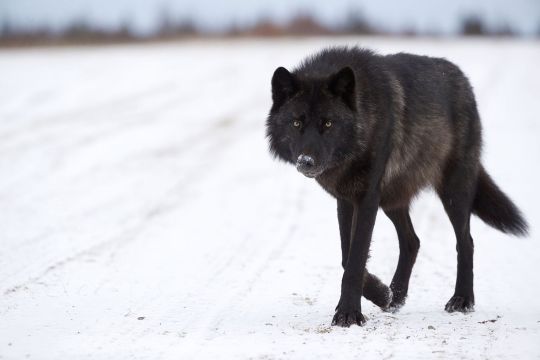
Our familiar friends have probably always been North American grey wolves, just pales ones! Despite their name, this iconic member of the canid family has an incredible amount of variation, and different subspecies of them are scattered all over North America.
Striped Wolf = Aardwolf
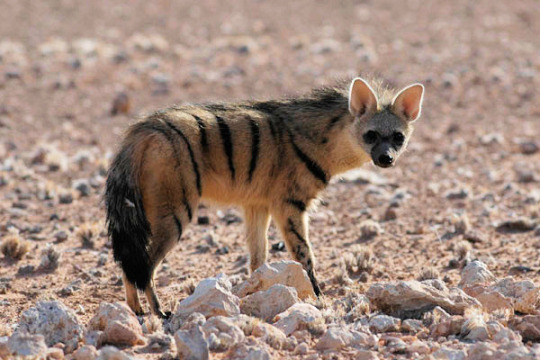
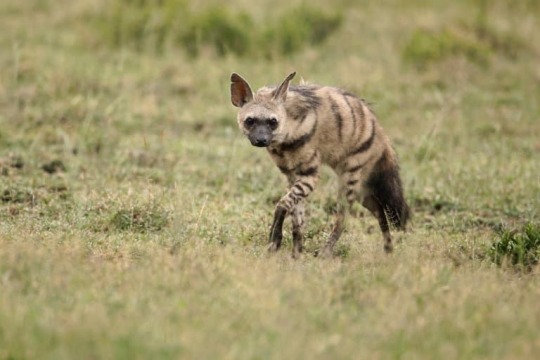
Okay, this is interesting, because they are definitely aardwolves! However, despite their names, aardwolves are actually the tiniest member of the hyaenidae family! Native to East and Southern Africa, they are exclusively insectivores and are known for following aardvarks to use their vacated burrows and foraging grounds. I think it's fascinating that a hyena was chosen for the wolf skins!
Snowy Wolf = Arctic Wolf
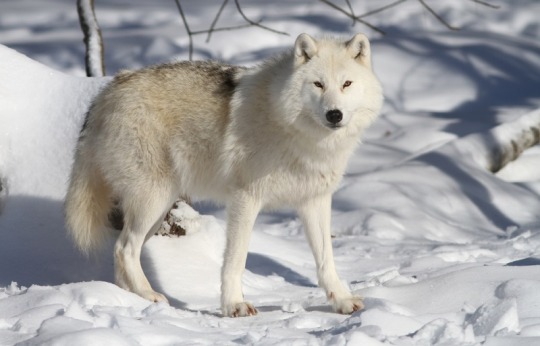
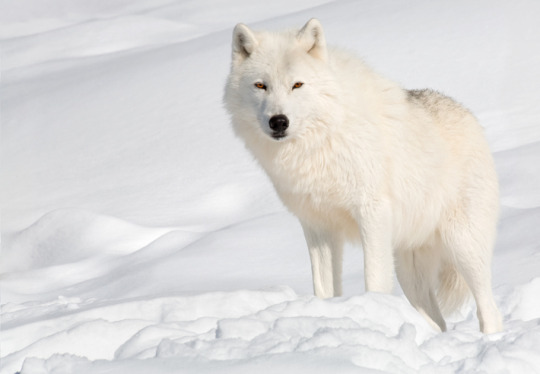
One of the many subspecies of gray wolves, arctic wolves are native to the Canadian Arctic and Alaska. Thanks to their territory being generally undesirable to humans, they are the only subspecies that can found across the entirety of their original range. Arctic wolves seem the most logical choice for snowy wolves, through there are several other pale-coated northern subspecies they could technically be.
Ashen Wolf = Northwestern Wolf

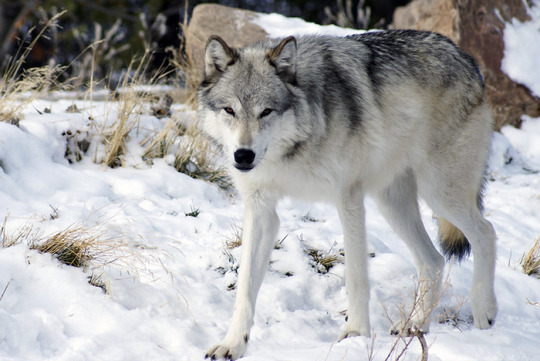
Speaking of northern subspecies, let's have some fun with the ashen variant. I'm pinning them as the Northwestern wolf, a.k.a. the Mackenzie Valley wolf! Native to, well, the northwestern part of Canada and Alaska, they are arguably the largest subspecies of wolf we know of. They match up pretty well with their Minecraft counterparts both in terms of habitat and possible coloration!
Woods Wolf = Eastern Wolf
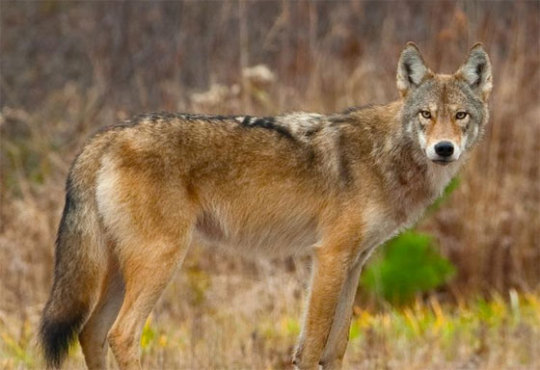
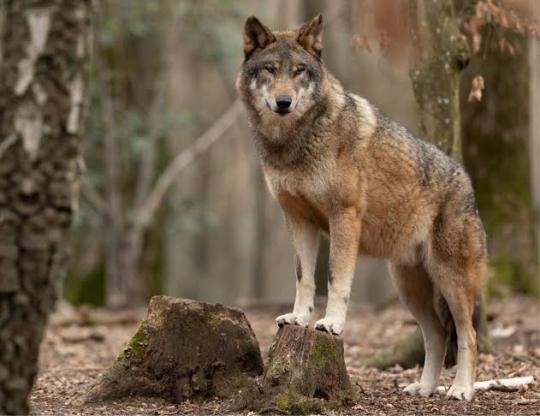
Ooo, okay, I went down a rabbit hole with this one! Eastern wolves, a.k.a Great Lakes wolves or Algonquin wolves, are native to the Great Lakes region of North America. They exist in an identification limbo, with no current ruling on whether they are a subspecies of grey wolf, red wolf, or their own unique branch that drifts closer to coyotes on the canid family tree. There is even some debate on whether the Great Lakes and Algonquin variants should be counted as the same subspecies, which I think is fascinating!
Spotted Wolf = African Wild Dog

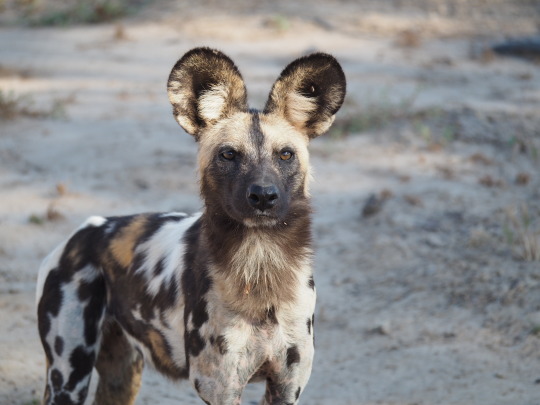
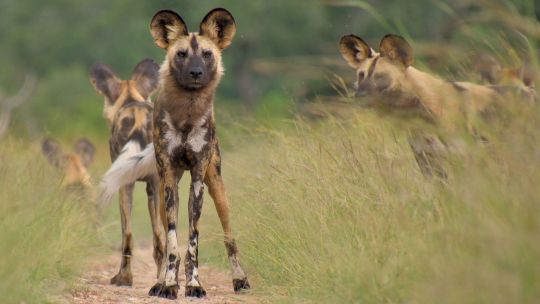
The more people who know these good bois exists, the happier I am. African wild dogs, a.k.a. painted dogs or Cape hunting dogs, are the largest wild canine in Africa. They live in packs of 5-30 members and are known their cooperative hunting tactics, using stamina to wear down prey. They're highly social animals, and you'll never find a lone dog.
Chestnut Wolf = Bat Eared Fox
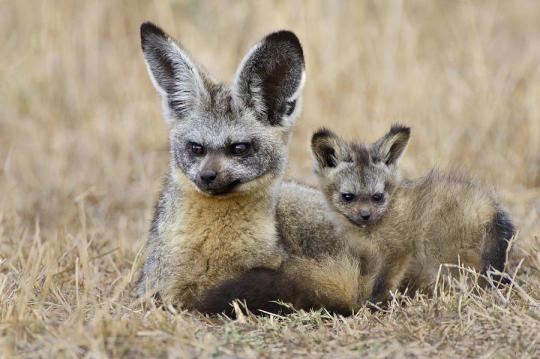
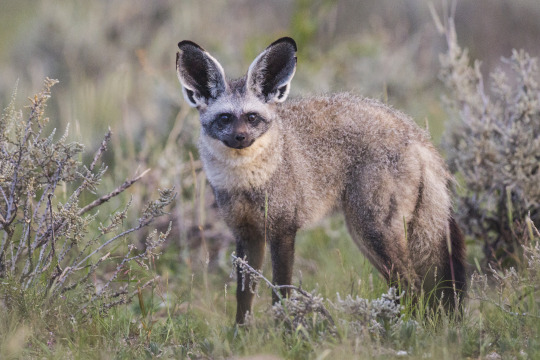
So, initially, I wrote off these guys cause I wasn't counting foxes, but I gave in. The chestnut wolves don't look like much of any existing canines, and nothing that lives in taiga forest. So, bat eared foxes are my best guess. They're small canids native to southern Africa, and are part of the subfamily Otocyoninae, which is a sister family to the families containing true foxes and racoon dogs.
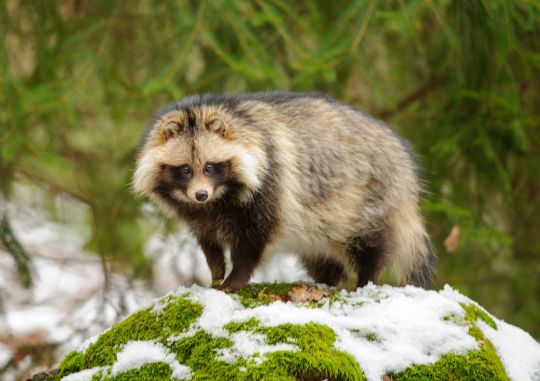
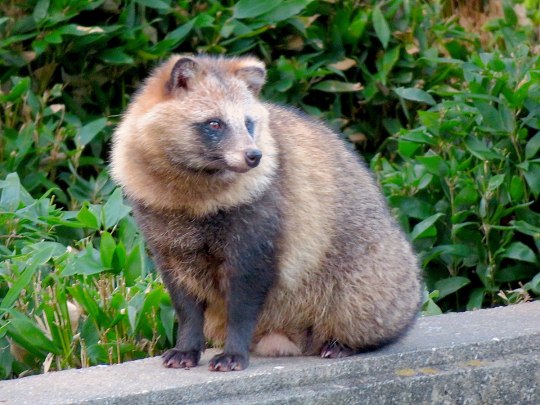
Speaking of raccoon dogs, they're my second best guess for the origin of the chestnut wolf. Their habitat makes slightly more sense, being from the forests of Japan and east Asia!
#i finally get to infodump on cool animals#also i learned A LOT researching for this!#minecraft#minecraft wolf#sharp has too many thoughts
27 notes
·
View notes
Text
There's a fusion in the animals of Palia that makes my brain roll around and want to inspect, for however much the design intentionally or unintentionally informs ecology. This is basically me talking about things to myself, but you're welcome to come along for the ride. The four I'm touching on are Flutterfoxes, Palcats, Plumehounds, and Silverwings, but I lost steam so I'll get back to it later. I'm also tacking on what this means for Sunny's lycanthropy involving bird aspects at the end, just as a head's up.
Flutterfoxes have floral imagery in the petal-like layering of their ears, with Fennec Fox-adjacent features. This plant-like camouflage could be reminiscent of a mantid or other insect, and their small stature compared to plumehounds could lean into a different food source niche for the two similar but divergent species? There are no flutterfoxes in game that can receive food, but it could be playfully assumed by the associations (camouflage, their butterfly-evoking name) they might enjoy a diet of insects and plants (or photosynthesis if legitimately a flora-fauna fusion). Maybe they were bred into domestication or "fancy" colorations and the features were exaggerated beyond a wild type, and the proclivities for insect-hunting became more pronounced? Palcats also have stated butterfly imagery, rather than the naming convention for flutterfoxes, so it could be argued that they in fact are the bred-down domesticated pets compared to flutterfoxes. There's something to be said for fusion versus patterning (Flutterfoxes/Plumehounds/Chapaa versus the less-fused Sernuk/Muujini/Palcats), so maybe I'll put a pin in Palcats in general.
Plumehounds are also foxlike, but their name (barely!!! to be fair) implies they may lie closer to fox-like canids (think South American foxes in genus Lycalopex like the gray and bat-eared foxes, but also some of the wolf-like canines in Canini Canina). They also have a proclivity to fungal matter, plant matter, and meat, which in both sub-sections of canids tracks as facultative. Their feathers suggest an influence of some sort of bird, though while the instinct to consider birds of prey as said influence seems reasonable, I'd argue their ability to enjoy a variety of foods besides meat may lean them into the realm of birds the likes of parrots or Galliformes. I considered corvids, too, but the plumage on the neck isn't as rounded and textured as I'd like compared to Tau's. By Tau's proclivities to mushrooms and root vegetables, I could see a case for a ground bird, and Tau's tendency to take and bury or chew things I've already alluded to feeling very parrot-like.
Silverwings are expressly described as birds of prey, and owing to the nest sites' proximity to fishing pools and that they migrate long enough distances to sleep on each other while flying, I'd suspect their lineage leaning in the vein of sea birds like Osprey. Their physical appearance leans Galliformes a little, understandably evoking peafowl with coloration, but they give off more Secretary Bird or Seriemas (another South American bird that does not fly much). It's interesting and I think something to think about with Plumehounds and Flutterfoxes as maybe being opportunistic (scavengers?) rather than abject obligate carnivore predators, and their morphology referencing in two ways more docile/not predatory winged creatures.
With respect to a strain of lycanthropy, or other therianthropies in the vein of what I'm imagining for Sunny (maybe created naturally from Flow as an, idk, virus essentially, but not giving her specifically any more attunement to Flow than any other humans), I'd think the design choices of a lot of creatures that have explicity predatory behaviors over scavaging might lean towards design choices similar to the silverwings.
Which, as the only other bird (besides Peki which I'd be glad to see too), I'd wonder how their version of the Phoenix falls in terms of influence. Is the deity a predatory bird (the way we'd assume a dragon is a predatory animal, and with the intelligence level of Majiri and humans I'd guess discerning at least)?
Unless Flow-based viruses/curses/what-have-you have deific implications, I don't think any deific designs should really play a role in therianthropic morphology, ultimately??
Idk I am full of thoughts and ponderings and I like animals but have such limited energy to deep dive any more lmao.
#palia#palia headcanons#i guess??#palia fauna#I started thinking about birds really#trying to understand what bird fusions mean ecologically#but I wanna eye the other things too eventually
12 notes
·
View notes
Text

Patagonian chilla (Lycalopex griseus griseus) Torres del Paine National Park, Chile
Photo © Gabriel Rojo
#chilla#south american gray fox#zorro#canids#south american canids#andean wildlife#south american wildlife#op
10 notes
·
View notes
Text

The Fuegian dog (Spanish: perro yagán, perro fueguino), also known as the Yahgan dog, is an extinct domesticated canid. It was a domesticated form of the culpeo (Lycalopex culpaeus).[1] The culpeo is similar in build to true foxes (tribe Vulpini) but is actually more closely related to wolves and jackals, being placed in a separate genus within the South American foxes or zorros. The Fuegian dog is not descended from domestic dogs, which were domesticated from an ancestor shared with the modern gray wolf (Canis lupus), nor from the domesticated silver fox which was domesticated from a melanistic population of the red fox (Vulpes vulpes).
Although the distribution of the Fuegian dog corresponded with that of the Yahgan people, individual animals were not loyal to their human owners. Julius Popper pointed out the canid's lack of loyalty: "I never saw them, no matter how large their number, take an aggressive attitude or defend their masters when these were in danger".[4]
Fuegian dogs were not used to hunt guanaco. However, they might have been useful for hunting otters.[3] The foxes were also useful to humans in that they would gather around their owners to keep them warm. This was noted by Julius Popper: "The dogs placed themselves in a group around the small Onas, taking the shape of a kind of wrapping .... [M]y opinion is that the Fuegian dogs are only useful to complete the defective garment of the Indian, or better, as the Ona's heating furniture".
In 1919, when Silesian missionary Martin Gusinde visited the local Yahgans, he noticed that, to his knowledge, all of the dogs seemed to be missing. He immediately noted this as odd, especially considering that the tie between the dogs and the local people was well documented by foreign missionaries and explorers by this time. Indeed, this mutual cooperation allowed for the region to become the only stronghold of this unusual domesticated canine to have ever existed. Upon speaking to the local people and inquiring about what had happened to the animals, he was told that the entire known population of them had been exterminated, and it was claimed they "were dangerous to men and cattle". Apparently, this "fierce" nature of the animal was allegedly witnessed by Thomas Bridges in the 1880s, who in his writings, purported that the dogs attacked his mission's goats, while giving few specific details.[5]
1919! your great-great-grandma could have seen them!
48 notes
·
View notes
Text


This animal was requested!
#animal polls#poll blog#my polls#mammalia#animals#canidae#canid#carnivore#near threatened#south american wildlife#south america#wildlife
49 notes
·
View notes
Text
reminder that foxes are weird ass animals
silver, black, cross, champagne, chocolate, lilac, ect foxes are all red foxes. those are color morphs.
pink champagne foxes are, unfortunately, a fur farm morph.
grey foxes, island foxes, crab-eating foxes, darwin's foxes, ect are not true foxes. lycalopex is the genus of zorros, meaning false foxes, and they are in the tribe of wolf and wolf-like canids and the substribe of south american canids
tibetan sand foxes are true foxes. ruppell's sand foxes are true foxes. swift foxes are true foxes. bengal foxes are true foxes. i have no joke heard people tell me all of those are not true foxes
they cant snarl. they. they cant snarl. the muscles in their face dont allow them to snarl
they make about 40 different sounds. none of them are from "what does the fox say" and whenever i hear that song i wish i could incinerated portal 1 style
saveafox does not deserve your money. saveafox does not deserve your money. the owner of saveafox owns a pet ruppell's sand fox and hoards animals. the foxes she has are kept in very improper conditions and feeding them KIBBLE is a 100% sure sign that you are not equipped to do this.
saveafox is a registered fur farm. saveafox buys foxes from fur farms, they do not 'rescue' them.
#those last two arent related to foxes being weird but its very important nonetheless#saveafox i hope you are incinerated portal 1 style
2 notes
·
View notes
Text
✦ C U C U F A T E ✦ CHARACTER PROFILE
Cucufate is Altaluna's (the protagonist) main ally in The Sorcerer’s Apprentice. Under the cut, you’ll find his complete profile! *I'll update this page as I come up with new details.
TAG LIST: (ask to be + or - ) @the-finch-address @achilleanmafia @fearofahumanplanet @winterninja-fr@avrablake @iced-ginger-tea @wildswrites @tate-lin @outpost51 @d3mon-ology @hippiewrites @threeking @lexiklecksi
I D - CARD
✦ Full Name: Cucufate or Cucuphas (I borrowed the name from the patron saint of petty thieves and kyphosis). Pronounced: "cook - ooo (as in "goo") - fa (as in "fa-la-la-la-la") - te (as in "telephone"). ✦ Age: Unknown ✦ Sex & Gender: Irrelevant, but I'm thinking male? ✦ Physical Description: Cucufate is a culpeo, a South American canid otherwise known as a Paramo Wolf or Andean Fox (although it bears a striking resemblance to the red fox, it's actually more closely related to wolves and coyotes). ✦ Occupation: One of Valeriano's Abandoned Projects.
INSPIRATION
✦ Socrates & Bartleby: (*I'm in the process of rewriting this section, as it isn't very clear. Thanks for your patience!) Cucufate is based on two figures: the ancient philosopher Socrates and Bartleby from the short story Bartleby, The Scrivener by Herman Melville. What I wanted to do with Cucufate was find a way to have an animal speak without necessarily resorting to a 'human' voice (a voice that furthers our aims, mimics and thus elevates our culture, clarifies and informs etc.). This is where Socrates and Bartleby enter the picture. They both provide a language model that subverts standard communication. For instance, despite being the primary character in Plato's Dialogues and one of the most famous philosophers of all time, Socrates makes no positive or prescriptive claims (thou shalt not blah, this is that etc.). Instead, he talks in (flattery &) questions, undermining any certainty his interlocutors might feel by prodding and probing their knowledge of x, y & z until they are forced to reveal their ignorance (this is known as Socratic irony). Socrates' speech is thus a kind of anti-speech. If it spotlights a topic, it does so only to reveal the immensity of the darkness that sustains it, its lack of substance. Indeed, whenever Socrates opens his mouth, he widens the abyss that will eventually swallow his interlocutor's thoughts and beliefs whole, and terminate the discussion (silence). Hence, Socratic dialogue successfully humiliates and confuses us. It strips us of that very human arrogance, our intellectual bravado, so that we too can become wise: so that we too can share in the wisdom of knowing that we don't know. Doesn't the natural world do the same? Isn't that precisely the horror of climate change? Bartleby, on the other hand, taps into the ambiguity of certain language formulas. His signature phrase "I would prefer not to," which he repeats whenever he's asked to do his job, expresses a hypothetical that... never seems to go anywhere? It's the Schrodinger's Cat of phrases, simultaneously dead and alive; he'd prefer not to, but... will he or won't he? Yes. The ambiguity, the inaction of it, dumfounds and incapacitates his employer. Bartleby's speech thus provides an example of a language that resists, confounds rather than clarifies, and complicates rather than simplifies. Like Socratic irony, Bartleby's masterful use of the conditional and modal auxiliary verb "would," disrupts the status quo. Because Cucufate's speech pattern draws from both of them, he becomes an effective helper to Altaluna; by engaging with her, he counteracts the temptation to think along the lines of a simplistic, "heroic" fascism (good vs. evil, light vs. darkness, us vs. them), and forces her instead to adopt a more nuanced stance, capable of aptly handing contradiction and ambiguity. (*Appropriated from this post).
✦ Cunning Intelligence in Greek Culture and Society by Marcel Detienne & Jean-Pierre Vernant: "When Oppian describes the cunning of the fishing frog squatting in the mud, motionless and invisible, he compares it to the fox: ‘The scheming fox (agkulómetis kerdō) devises a similar trick; as soon as it spots a flock of wild birds it lies down on its side, stretches out its agile limbs, closes its eyelids and shuts its mouth. To see it you would think that it was enjoying a deep sleep or even that it was really dead, so well does it hold its breath as it lies stretched out there, all the while turning over treacherous plots (aióla bouleúousa) in its mind. No sooner do the birds notice it than they swoop down on it in a flock and, as if in mockery, tear at its coat with their claws, but as soon as they are within reach of its teeth the fox reveals its cunning (dólos) and seizes them unexpectedly. The fox is a trap; when the right moment comes the dead creature becomes more alive than the living. [….] If the metis of the fox is immediately detectable in its skill at playing dead, it is dazzlingly apparent in this sudden reversal. In effect, the fox holds the secret of reversal which is the last word in craftiness." (pp. 35-36)
© 2023 The Sorcerer’s Apprentice. All rights reserved.
#WIP: THE SORCERER'S APPRENTICE#writeblr#writeblr community#writers of tumblr#writers on tumblr#wip#writing community#writblr community#wtw community#writblr#writer community#the sorcerer's apprentice#CHARACTER: CUCUFATE
6 notes
·
View notes
Text
i love south american native canids. goofy ass dogs
17 notes
·
View notes
Video
Grey Fox - Three Pups by Len Radin Via Flickr: A family of two adult and three immature grey fox live in a den in the ground in our back yard just twenty feet from our house. These are the pups. (from Wikipedia) The gray fox (Urocyon cinereoargenteus) is a carnivorous mammal of the family Canidae ranging throughout most of[3] the southern half of North America from southern Canada to the northern part of South America (Venezuela and Colombia).[1] No other canid's natural range spans both North and South America and it is the only American canid that can climb trees.[4] This species and its only congener, the diminutive Channel Island fox (Urocyon littoralis), are the only living members of the genus Urocyon, which is considered to be the most basal of the living canids.[5] Though it was once the most common fox in the eastern United States, and still is found there,[3][6][7] human advancement and deforestation allowed the red fox to become more dominant. The Pacific States still have the gray fox as a dominant. Its specific epithet cinereoargenteus means 'ashen silver'. Tenuous Link: animal babies
2 notes
·
View notes